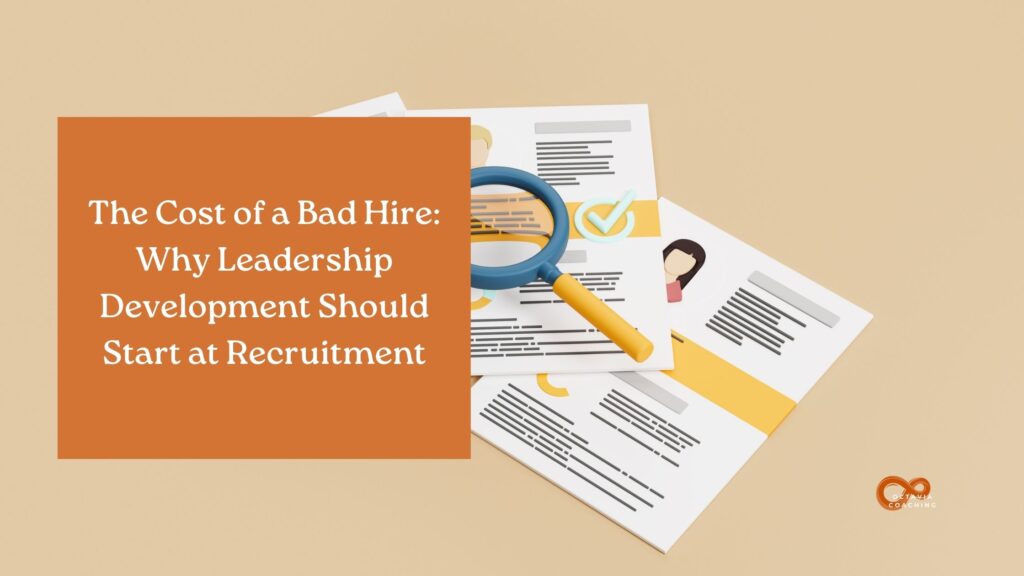Introduction
Hiring the right talent is crucial for organisational success. A poor hiring decision can have far-reaching consequences, affecting not just the individual in question but also the broader team, organisational culture, and long-term business performance. The financial implications are substantial, with costs extending beyond salary to include recruitment, training, severance, and lost productivity.
Beyond the direct monetary losses, a bad hire can disrupt team cohesion, lower morale, and lead to disengagement among employees who must compensate for underperformance. When hiring mistakes are frequent, organisations may struggle with high turnover rates, resulting in instability and reduced competitiveness. Moreover, the reputational damage from poor hiring decisions can deter top talent and erode trust among clients and stakeholders.
To mitigate these risks, leadership development should begin at the recruitment stage. Identifying candidates with strong leadership potential, cultural alignment, and adaptability ensures that new hires contribute positively to the organisation’s long-term goals. This article explores the true cost of a bad hire, its wider implications, and why businesses should integrate leadership assessment into their hiring processes to drive retention and performance.
Problem Statement
Many businesses struggle with high employee turnover and underperformance, often stemming from poor hiring choices. Traditional recruitment focuses primarily on technical skills and experience, overlooking leadership potential and cultural fit. The absence of leadership qualities in new hires can hinder long-term success, leading to disengagement and inefficiency. This issue affects organisations of all sizes, with small and medium-sized enterprises (SMEs) feeling the impact most acutely due to limited resources.
Background Information
The financial burden of a bad hire is significant. According to the Chartered Institute of Personnel and Development (CIPD, 2023), replacing an employee can cost up to 30% of their annual salary. Additionally, a report by the Recruitment & Employment Confederation (REC, 2022) found that hiring the wrong person for a mid-level role can cost businesses over £132,000 when considering recruitment, onboarding, lost productivity, and severance.
However, the implications extend far beyond financial costs. A poor hiring decision can negatively impact team dynamics, leading to decreased morale, disengagement, and a decline in overall productivity. Employees who witness poor performance or high turnover may become demotivated, reducing their commitment to the organisation.
Furthermore, a bad hire can damage an organisation’s reputation. In today’s digital world, employer review platforms such as Glassdoor allow employees to share their experiences publicly. Consistently poor hiring decisions can result in negative reviews, making it difficult to attract high-quality talent. Clients and stakeholders may also lose confidence in an organisation that frequently struggles with staff retention and performance issues, impacting long-term business relationships and growth potential.
Industry Trends and Challenges
- Short-Term Focus on Skills: Many organisations prioritise immediate technical competencies over long-term leadership potential, resulting in hires who may struggle with adaptability and strategic thinking.
- High Turnover Rates: Poor hiring choices contribute to increased turnover, affecting business continuity and morale. The CIPD (2023) highlights that UK employee turnover rates have risen to 35% in some sectors.
- Changing Workforce Expectations: Employees today seek career development and alignment with organisational values. Failure to assess these factors at recruitment can lead to disengagement and early exits.
Proposed Solution
To mitigate the risks of a bad hire, organisations must integrate leadership development into their recruitment processes. This can be achieved through:
- Competency-Based Hiring: Implementing structured interview techniques that assess leadership skills, problem-solving abilities, and cultural fit.
- Psychometric and Behavioural Assessments: Utilising validated assessments to identify leadership traits and potential growth areas.
- Onboarding and Early Development Programmes: Providing structured leadership training within the first six months to enhance engagement and performance.
- Hiring for Future Growth: Prioritising candidates with a long-term vision and adaptability to align with organisational goals.
Supporting Data and Evidence
- Leadership Potential Improves Retention: A study by McKinsey & Company (2022) found that companies investing in leadership assessment at recruitment see a 20% reduction in turnover.
- Enhanced Hiring Processes Lead to Higher Performance: Research from the Harvard Business Review (2021) indicates that organisations using competency-based hiring practices report a 40% improvement in employee performance.
- Financial Savings: The REC (2022) states that businesses implementing structured hiring and leadership development programmes can reduce hiring costs by 25% over five years.
Conclusion
The impact of a bad hire extends far beyond initial recruitment costs, affecting productivity, morale, and long-term success. By embedding leadership development into recruitment strategies, businesses can enhance retention, improve performance, and create a resilient workforce. Investing in the right hiring practices today leads to sustainable growth and competitive advantage in the future.
References
- Chartered Institute of Personnel and Development (CIPD). (2023). Employee Retention and Turnover Report. Retrieved from https://www.cipd.co.uk
- Recruitment & Employment Confederation (REC). (2022). The Hidden Costs of Poor Hiring Decisions. Retrieved from https://www.rec.uk.com
- McKinsey & Company. (2022). Leadership in Hiring: A Long-Term Investment. Retrieved from https://www.mckinsey.com
- Harvard Business Review. (2021). The Impact of Competency-Based Hiring on Organisational Performance. Retrieved from https://hbr.org

